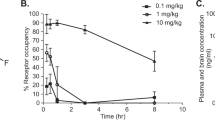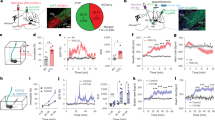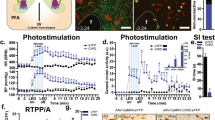Abstract
Panic disorder is a severe anxiety disorder with recurrent, debilitating panic attacks. In individuals with panic disorder there is evidence of decreased central γ-aminobutyric acid (GABA) activity as well as marked increases in autonomic and respiratory responses after intravenous infusions of hypertonic sodium lactate1,2,3. In a rat model of panic disorder, chronic inhibition of GABA synthesis in the dorsomedial-perifornical hypothalamus of rats produces anxiety-like states and a similar vulnerability to sodium lactate–induced cardioexcitatory responses4,5,6,7,8,9. The dorsomedial-perifornical hypothalamus is enriched in neurons containing orexin (ORX, also known as hypocretin)10, which have a crucial role in arousal10,11, vigilance10 and central autonomic mobilization12, all of which are key components of panic. Here we show that activation of ORX-synthesizing neurons is necessary for developing a panic-prone state in the rat panic model, and either silencing of the hypothalamic gene encoding ORX (Hcrt) with RNAi or systemic ORX-1 receptor antagonists blocks the panic responses. Moreover, we show that human subjects with panic anxiety have elevated levels of ORX in the cerebrospinal fluid compared to subjects without panic anxiety. Taken together, our results suggest that the ORX system may be involved in the pathophysiology of panic anxiety and that ORX antagonists constitute a potential new treatment strategy for panic disorder.
This is a preview of subscription content, access via your institution
Access options
Subscribe to this journal
Receive 12 print issues and online access
$209.00 per year
only $17.42 per issue
Buy this article
- Purchase on Springer Link
- Instant access to full article PDF
Prices may be subject to local taxes which are calculated during checkout




Similar content being viewed by others
References
Goddard, A.W. et al. Reductions in occipital cortex GABA levels in panic disorder detected with 1h-magnetic resonance spectroscopy. Arch. Gen. Psychiatry 58, 556–561 (2001).
Goddard, A.W. et al. Impaired GABA neuronal response to acute benzodiazepine administration in panic disorder. Am. J. Psychiatry 161, 2186–2193 (2004).
Roy-Byrne, P.P., Craske, M.G. & Stein, M.B. Panic disorder. Lancet 368, 1023–1032 (2006).
Johnson, P.L. & Shekhar, A. Panic-prone state induced in rats with GABA dysfunction in the dorsomedial hypothalamus is mediated by NMDA receptors. J. Neurosci. 26, 7093–7104 (2006).
Johnson, P.L., Truitt, W.A., Fitz, S.D., Lowry, C.A. & Shekhar, A. Neural pathways underlying lactate-induced panic. Neuropsychopharmacology 33, 2093–2107 (2008).
Shekhar, A. et al. Angiotensin-II is a putative neurotransmitter in lactate-induced panic-like responses in rats with disruption of GABAergic inhibition in the dorsomedial hypothalamus. J. Neurosci. 26, 9205–9215 (2006).
Shekhar, A. & Keim, S.R. The circumventricular organs form a potential neural pathway for lactate sensitivity: implications for panic disorder. J. Neurosci. 17, 9726–9735 (1997).
Shekhar, A. & Keim, S.R. LY354740, a potent group II metabotropic glutamate receptor agonist prevents lactate-induced panic-like response in panic-prone rats. Neuropharmacology 39, 1139–1146 (2000).
Shekhar, A., Keim, S.R., Simon, J.R. & McBride, W.J. Dorsomedial hypothalamic GABA dysfunction produces physiological arousal following sodium lactate infusions. Pharmacol. Biochem. Behav. 55, 249–256 (1996).
Sakurai, T. The neural circuit of orexin (hypocretin): maintaining sleep and wakefulness. Nat. Rev. Neurosci. 8, 171–181 (2007).
Brisbare-Roch, C. et al. Promotion of sleep by targeting the orexin system in rats, dogs and humans. Nat. Med. 13, 150–155 (2007).
Ferguson, A.V. & Samson, W.K. The orexin/hypocretin system: a critical regulator of neuroendocrine and autonomic function. Front. Neuroendocrinol. 24, 141–150 (2003).
American Psychiatric Association. Diagnostic and Statistical Manual of Mental Disorders (DSM-IV-TR) 4th edn. 429–440 (American Psychiatric Association, Washington, DC, 2005).
Liebowitz, M.R. et al. Possible mechanisms for lactate's induction of panic. Am. J. Psychiatry 143, 495–502 (1986).
Cowley, D.S., Dager, S.R., Roy-Byrne, P.P., Avery, D.H. & Dunner, D.L. Lactate vulnerability after alprazolam versus placebo treatment of panic disorder. Biol. Psychiatry 30, 49–56 (1991).
Liebowitz, M.R. et al. Alprazolam in the treatment of panic disorders. J. Clin. Psychopharmacol. 6, 13–20 (1986).
Gorman, J.M. et al. Anxiogenic effects of CO2 and hyperventilation in patients with panic disorder. Am. J. Psychiatry 151, 547–553 (1994).
Shekhar, A., Sajdyk, T.J., Gehlert, D.R. & Rainnie, D.G. The amygdala, panic disorder, and cardiovascular responses. Ann. NY Acad. Sci. 985, 308–325 (2003).
de Lecea, L. et al. The hypocretins: hypothalamus-specific peptides with neuroexcitatory activity. Proc. Natl. Acad. Sci. USA 95, 322–327 (1998).
Kayaba, Y. et al. Attenuated defense response and low basal blood pressure in orexin knockout mice. Am. J. Physiol. Regul. Integr. Comp. Physiol. 285, R581–R593 (2003).
Chou, T.C. et al. Orexin (hypocretin) neurons contain dynorphin. J. Neurosci. 21, RC168 (2001).
Ishii, Y. et al. Anorexia and weight loss in male rats 24 h following single dose treatment with orexin-1 receptor antagonist SB-334867. Behav. Brain Res. 157, 331–341 (2005).
Johnson, P.L., Truitt, W.A., Fitz, S.D., Lowry, C.A. & Shekhar, A. Neural pathways underlying lactate-induced panic. Neuropsychopharmacology 33, 2093–2107 (2007).
Rupprecht, R. et al. Translocator protein (18 kD) as target for anxiolytics without benzodiazepine-like side effects. Science 325, 490–493 (2009).
Andreatini, R. et al. The brain decade in debate: II. Panic or anxiety? From animal models to a neurobiological basis. Braz. J. Med. Biol. Res. 34, 145–154 (2001).
Boshuisen, M.L., Ter Horst, G.J., Paans, A.M., Reinders, A.A. & den Boer, J.A. rCBF differences between panic disorder patients and control subjects during anticipatory anxiety and rest. Biol. Psychiatry 52, 126–135 (2002).
Grillon, C., Ameli, R., Goddard, A., Woods, S.W. & Davis, M. Baseline and fear-potentiated startle in panic disorder patients. Biol. Psychiatry 35, 431–439 (1994).
Ludewig, S., Ludewig, K., Geyer, M.A., Hell, D. & Vollenweider, F.X. Prepulse inhibition deficits in patients with panic disorder. Depress. Anxiety 15, 55–60 (2002).
Salomon, R.M. et al. Diurnal variation of cerebrospinal fluid hypocretin-1 (Orexin-A) levels in control and depressed subjects. Biol. Psychiatry 54, 96–104 (2003).
Brundin, L., Bjorkqvist, M., Petersen, A. & Traskman-Bendz, L. Reduced orexin levels in the cerebrospinal fluid of suicidal patients with major depressive disorder. Eur. Neuropsychopharmacol. 17, 573–579 (2007).
Samuels, B.C., Zaretsky, D.V. & DiMicco, J.A. Dorsomedial hypothalamic sites where disinhibition evokes tachycardia correlate with location of raphe-projecting neurons. Am. J. Physiol. Regul. Integr. Comp. Physiol. 287, R472–R478 (2004).
Shekhar, A., Keim, S.R., Simon, J.R. & McBride, W.J. Dorsomedial hypothalamic GABA dysfunction produces physiological arousal following sodium lactate infusions. Pharmacol. Biochem. Behav. 55, 249–256 (1996).
De Boer, S.F. & Koolhaas, J.M. Defensive burying in rodents: ethology, neurobiology and psychopharmacology. Eur. J. Pharmacol. 463, 145–161 (2003).
Acknowledgements
This work was supported by grants from the US National Institute of Mental Health (RO1 MH52619 and RO1 MH065702 to A.S.), the National Center for Research Resources (UL1RR025761 to A.S.), the Anxiety Disorders Association of America (Junior Faculty Research Award to P.L.J.), the National Alliance for Research on Schizophrenia and Depression (Young Investigator Award to P.L.J.), the Swedish Research Council (no. 14548) and the Swedish Government State Grants (L.T.-B. and L.B.).
Author information
Authors and Affiliations
Contributions
A.S., P.L.J. and W.T. formulated the hypotheses and designed the studies. S.D.F. and P.L.J. performed telemetrical probe surgeries. SD.F. and P.L.J. scored all behavior, and S.D.F. performed all stereotaxic surgeries. P.L.J. performed the immunohistochemistry. P.E.M. and A.D. performed all RT-PCR assays with technical expertise from W.T. and S.S. P.L.J. and W.T. analyzed all rat data. L.T.-B. and L.B. were responsible for the human subject study, the ORX assays of the CSF samples and the analysis of the human data. P.L.J., W.T. and A.S. interpreted the data and collectively wrote the main draft of the article. P.L.J., W.T., .S.D.F., A.D., P.E.M., L.B., L.T.-B., A.W.G. and A.S. contributed to the writing of the manuscript and have approved the final version.
Corresponding author
Supplementary information
Supplementary Text and Figures
Supplementary Methods, Supplementary Results, Supplementary Figures 1–5 and Supplementary Tables 1 and 2 (PDF 738 kb)
Rights and permissions
About this article
Cite this article
Johnson, P., Truitt, W., Fitz, S. et al. A key role for orexin in panic anxiety. Nat Med 16, 111–115 (2010). https://doi.org/10.1038/nm.2075
Received:
Accepted:
Published:
Issue Date:
DOI: https://doi.org/10.1038/nm.2075
This article is cited by
-
Orexin Receptor Antagonists in the Treatment of Depression: A Leading Article Summarising Pre-clinical and Clinical Studies
CNS Drugs (2023)
-
Molecular and cellular mechanisms for differential effects of chronic social isolation stress in males and females
Molecular Psychiatry (2022)
-
Acute orexin antagonism selectively modulates anticipatory anxiety in humans: implications for addiction and anxiety
Translational Psychiatry (2022)
-
A genetically encoded sensor for in vivo imaging of orexin neuropeptides
Nature Methods (2022)
-
Insulin-like growth factor I mitigates post-traumatic stress by inhibiting AMP-kinase in orexin neurons
Molecular Psychiatry (2022)



